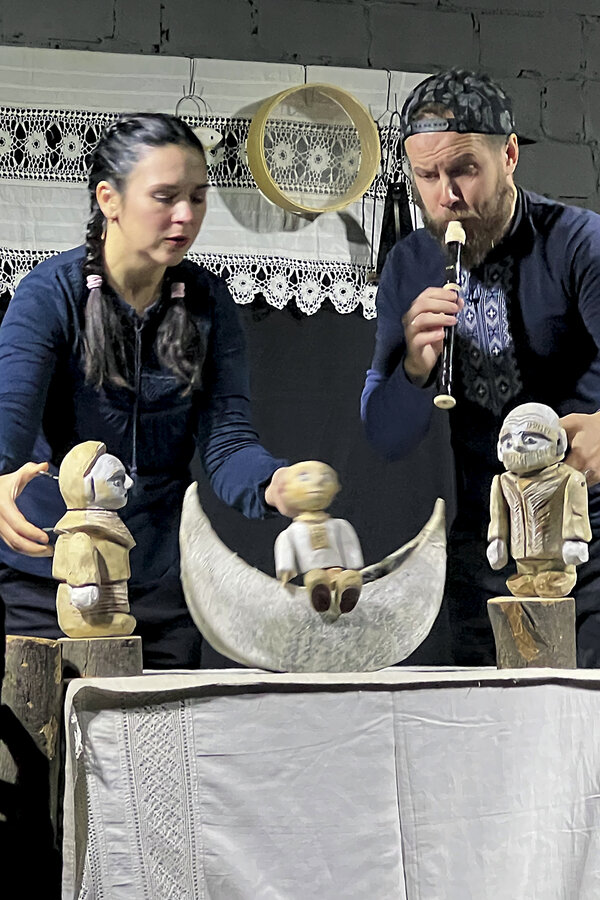Laughter, with no strings attached: Ukrainian puppeteers bring joy amid war
Loading...
| Kharkiv, Ukraine
Puppeteer Pavlo Saveliev opens the Sunday afternoon show with some questions for an audience that includes several dozen children.
“Do you know how to behave in the theater?” he asks with faux seriousness, proceeding to a series of rapid-fire queries.
“Can you eat candy?” he probes. The children respond firmly, “No!”
Why We Wrote This
A story focused onThe calamitous war in Ukraine has raged for three years. A theater troupe is finding that puppets have a special ability to comfort and inspire audiences.
Is it OK to eat popcorn or to talk loudly? “No!” comes the resounding answer each time.
Then Mr. Saveliev smiles wryly and asks a trick question.
“Is it OK to laugh?” he inquires. When once again the children shout “No,” he booms back at them: “Oh, but yes! Yes, you may laugh! Especially during these hard times, please laugh as much as you wish!”
For the next hour, the laughter is indeed copious as the children delight to a traditional tale, related through puppets, of a brave boy named Ivasyk and his silly but faithful animal sidekicks who together best an evil ogre. For Mr. Saveliev and the rest of the troupe at Kharkiv State Academic Puppet Theater, this laughter brings with it a sense of “mission accomplished.” It’s also a reminder of why they keep the show going despite the war raging around them.
“If we can help the people of Kharkiv, but especially the children, to forget even for a short time the fear, the sadness, and the terrible loss they are experiencing because of this war,” Mr. Saveliev says, “then we feel that what we are doing is very much worth it.”
Puppets have been a part of Kharkiv, Ukraine’s second-largest city, at least since the city rivaled St. Petersburg as a center of culture and higher education during the Russian Empire. The puppet theater academy was founded during the Soviet era, and its grand theater building showcases the important role puppetry has played in a city known for theatrical arts.
But Russia’s full-scale invasion of Ukraine in February 2022 dealt Kharkiv’s puppetry a heavy blow, as much of the city’s population of 1.4 million evacuated in the face of the Russian onslaught. The puppet theater closed its doors.
Yet, as it turned out, not for long.
Inspired by the resilience and steely resistance of the city’s residents, the theater restarted its shows within months of the invasion – albeit in Kharkiv’s underground subway stations, where many families sought emergency shelter from Russian bombs. Three years later, a significant portion of the Kharkivites who fled their city have returned, even though the war – and the random bombings that kill civilians and devastate neighborhoods – continues.
“A rich life despite everything”
Mirroring a stubborn city’s revival, the puppet theater has left the subway. It operates instead in a basement space that allows the show to go on even if air raid sirens blare.
“So many people have returned; businesses are reopening every day even though our neighbors are just as active towards us,” says puppeteer Dariia Kushnirenko, referring to a belligerent Russia, which looms just 20 miles east of Kharkiv. “We are determined to be part of what helps people not just to keep going, but to have a rich life despite everything.”
For Oksana, a foster mother of six orphaned children whom she and her husband have brought to the show on this cold November day, the lessons the puppets convey are almost as important as the laughter they elicit. “We came here because we knew it would make the children happy, but it’s also important that they learn through the story that life goes on, that we all have trials but life wins over death,” says Oksana, who declined to give her last name.
“Especially in these times, there is a lot of negativity and anxiety in our daily life,” she adds, noting that her adult son is fighting on the front lines near the embattled city of Pokrovsk. “But here we get a slice of positivity and a reminder that there is good. And for the children,” she adds with a touch of maternal wit and wisdom, “that message of positivity might be better received from a little boy puppet.”
When queried, the younger children in Oksana’s foster family say they liked the show because it was funny, or because the boy puppet Ivasyk had friends. And they liked the action scenes in which the puppets bonked one another on the head.
But 15-year-old Olena takes a question about the show’s value more seriously. “With this funny tale, we are able to understand what is good and what is evil in the world,” says the devoted “Harry Potter” fan. “We see that in the end evil loses and good lives on in us.”
A blossoming of the arts
Lesson-learning amid the laughter has been the goal of Ms. Kushnirenko and Mr. Saveliev as the Kharkiv academy has taken its puppetry around Ukraine and to other European cities in recent years. And according to Mr. Saveliev, who is a member of a Kharkiv volunteer army unit, the nationalist aspects of the troupe’s work have blossomed in response to Russia’s aggression.
“With our home under attack, we have incorporated pride in our country and more references to our roots as Ukrainians into our shows,” he says. Noting that about half the academy’s staff joined him in the army unit that became known as the Puppet Defense Forces, he says puppetry and the defense of Ukraine became intertwined.
In May 2022, when the academy restarted shows in the subway, the traditional story of a boy setting off on adventures that teach him life lessons was adapted to portray a displaced family persevering and defending its home against an evil aggressor.
At Christmastime, the academy adapted a classical Ukrainian tradition of presenting the Nativity story with puppets to tell a tale of Cossack warriors defending children and families – one with a newborn baby – against Russian invaders. “In the end, the Cossacks win,” Mr. Saveliev says, “and they all sing, ‘All will be well!’”
Mr. Saveliev and Ms. Kushnirenko, who are married with two children, say they learn from their sons what works with young audiences and what risks falling flat.
Presenting their shows to children living through frightening times has only deepened Ms. Kushnirenko’s conviction that puppets have a special ability to heal and fortify their audience.
“When you see a mother in the audience crying, and the children with wide eyes and absorbing every moment, you realize the role puppets can play in rehabilitation,” she says, cradling one of the puppets. “They really can restore a sense of security and strength to go forward where before there was only shock and sadness.”







